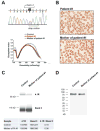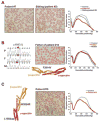Genotype-phenotype correlations in hereditary elliptocytosis and hereditary pyropoikilocytosis
- PMID: 27667160
- PMCID: PMC5098801
- DOI: 10.1016/j.bcmd.2016.07.003
Genotype-phenotype correlations in hereditary elliptocytosis and hereditary pyropoikilocytosis
Abstract
Hereditary elliptocytosis (HE) and hereditary pyropoikilocytosis (HPP) are heterogeneous red blood cell (RBC) membrane disorders that result from mutations in the genes encoding α-spectrin (SPTA1), β-spectrin (SPTB), or protein 4.1R (EPB41). The resulting defects alter the horizontal cytoskeletal associations and affect RBC membrane stability and deformability causing shortened RBC survival. The clinical diagnosis of HE and HPP relies on identifying characteristic RBC morphology on peripheral blood smear and specific membrane biomechanical properties using osmotic gradient ektacytometry. However, this phenotypic diagnosis may not be readily available in patients requiring frequent transfusions, and does not predict disease course or severity. Using Next-Generation sequencing, we identified the causative genetic mutations in fifteen patients with clinically suspected HE or HPP and correlated the identified mutations with the clinical phenotype and ektacytometry profile. In addition to identifying three novel mutations, gene sequencing confirmed and, when the RBC morphology was not evaluable, identified the diagnosis. Moreover, genotypic differences justified the phenotypic differences within families with HE/HPP.
Keywords: Elliptocytosis; Hemolytic anemia; Mutation; Pyropoikilocytosis; Red blood cell membrane.
Copyright © 2016 Elsevier Inc. All rights reserved.
Figures



References
-
- Gallagher PG. Hereditary elliptocytosis: spectrin and protein 4.1R. Semin Hematol. 2004;41:142–164. - PubMed
-
- Cherry L, Menhart N, Fung LW. Interactions of the alpha-spectrin N-terminal region with beta-spectrin. Implications for the spectrin tetramerization reaction. J Biol Chem. 1999;274:2077–2084. - PubMed
-
- Da Costa L, Galimand J, Fenneteau O, Mohandas N. Hereditary spherocytosis, elliptocytosis, and other red cell membrane disorders. Blood Rev. 2013;27:167–178. - PubMed
-
- An X, Mohandas N. Disorders of red cell membrane. Br J Haematol. 2008;141:367–375. - PubMed
Publication types
MeSH terms
Substances
Supplementary concepts
Grants and funding
LinkOut - more resources
Full Text Sources
Other Literature Sources

